Featured Application
Proof-of-concept versions of mixed-reality applications for controlling and monitoring a digital twin-based roadheader with timeliness, accuracy, and reliability, and the general architecture of a mixed-reality digital twin monitoring system for a roadheader is constructed.
Abstract
The working environment of the coal mine boom-type roadheader is harsh with large blind areas and numerous safety hazards for operators. Traditional on-site or remote control methods do not meet the requirements for intelligent tunneling. This paper proposes a digital twin monitoring system of an EBZ-type roadheader based on mixed reality (MR). First, the system integrates a five-dimensional digital twin model to establish the boom-type roadheader digital twin monitoring system. Second, the Unity3D software (v2020.3.25f1c1) and the MR Hololens (v22621.1133 produced by Microsoft) are used to build a digital twin human–machine interaction platform, achieving bidirectional mapping and driving of cutting operation data. Third, a twin data exchange program is designed by employing the Winform framework and the C/S communication architecture, making use of the socket communication protocol to transmit and store the cutting model data within the system. Finally, a physical prototype of the boom-type roadheader is built, and a validation experiment of the monitoring system’s digital twin is conducted. The experimental results show that the average transmission error of the cutting model data of the twin monitoring system is below 0.757%, and the execution accuracy error is below 3.7%. This system can achieve bidirectional real-time mapping and control between the twins, which provides a new monitoring method for actual underground roadheader operations. It effectively eliminates the operator’s blind areas and improves the intelligence level of roadheader monitoring. Beyond mining, this methodology can be extended to the monitoring and control of other mining equipment, predictive maintenance in manufacturing, and infrastructure management in smart cities.
1. Introduction
Coal provides a solid guarantee for China’s economic and social development and a stable supply for national energy security [1]. The proven coal resources in China amount to approximately 6 trillion tons, and over 50% of them are distributed in deep layers, resulting in the continuous increase in the coal mining depth and the gradual escalation of mining difficulty [2]. A roadheader is a mining equipment employed to crush rock or coal and load it onto vehicles such as trucks, conveyors, and transfer machines, which accomplishes the three primary operations of cutting, loading, and transporting ore to other transportation tools [3]. The coal mine roadheader is an exceptionally dangerous equipment because when it operates, the rock is crushed under pressure. When coal and rock burst suddenly, a large quantity of gas (mainly methane) is released. In the air mixture after ejection, the concentration of methane can reach 100%, which might cause significant casualties [4]. Realizing the visual remote monitoring of the roadheader and keeping the roadheader operators away from the harsh environment can effectively improve the working conditions of underground personnel, guarantee the personal safety of workers, and improve work efficiency, all of which hold great significance for achieving the intelligent unmanned mining of deep coal mines [5,6,7].
However, the realization of the remote monitoring of roadheaders still encounters numerous problems. Factors such as low underground illumination, high dust concentration, water mist generated during cutting operations, and electromagnetic interference lead to poor imaging quality, restricting the application of traditional video monitoring technologies. Another instance is that the positioning technology of the roadheader is not yet mature and reliable. The positioning error of inertial navigation technology accumulates over time, and visual positioning is also challenging to apply due to the interference of the roadway environment [8].
The digital twin, as a novel type of digital technology for system modeling, monitoring, and analysis, can be an effective solution to the challenges mentioned above [9]. It is an organic combination of several technologies, including physical sensing technology, data processing and analysis technology, simulation technology, and computer technology, etc. [10,11].
The digital twin emphasizes the two-way interaction and mapping of information between the physical world and the digital space [12], that is, the twinning of data. A digital twin system comprises two twins: the physical entity and the digital model. Through virtual modeling of physical objects in the real world to obtain the corresponding digital model, and with the aid of data processing technology and digital simulation technology to fulfill the monitoring, control, diagnosis, prediction, and other functions of the physical entity, the physical entity and the digital model are connected at an appropriate synchronization rate via digital communication technology to realize the two-way mapping between the physical entity and the digital model [13]. Thus, it becomes possible to comprehensively and stereoscopically present the excavation information to the driver at the visualization terminal, enhancing the driver’s visual perception and situational awareness. This allows for greater transparency and efficiency in the excavation process while minimizing the interference of the complex roadway environment on the driver.
Digital twin technology has long had application precedents in intelligent coal mining and is becoming increasingly widespread. Ge et al. introduced 5G communication technology, IoT technology, and bionic intelligence technology into the traditional fully mechanized mining face and proposed the concept of a digital twin intelligent mining face [14]. Zhang et al. verified the feasibility of the digital twin-driven intelligent control system of the cantilever roadheader by deeply integrating the physical entity of the tunneling face with the digital virtual model of tunneling information and making this interaction bidirectional [15,16,17]. Hu et al. conducted in-depth research on the driving and bolting integration machine through the physical simulation and real-time driving technology of historical data and carried out the kinematic fast simulation analysis of the driving and bolting integration machine [18].
Traditional visualization terminals are often based on VR technology or AR technology. VR technology utilizes computer equipment to render a three-dimensional digital virtual space, and its hardware limits the user’s field of vision, thereby weakening the user’s perception ability of the real environment [19]. AR technology can use a computer to superimpose virtual information and render it into a video stream, then overlay the video stream onto the physical environment, and interact with the user through program control, but the mutual influence between the virtual and the real is very limited [20]. MR, as an imaging technology between VR and AR, possesses both the human–computer interaction characteristics of VR technology and the reality fusion characteristics of AR technology, and has the unique advantage of strong virtual–real interaction, that is, it can achieve “coexistence and interaction of the virtual and the real” [21].
This paper takes the EBZ roadheader as the research object. Aiming at solving the problems of the complex tunneling roadway environment, serious interference, large blind area for the driver’s field of vision, difficult precise operation, and low transparency of cutting information, a construction method of an MR digital twin monitoring system of the EBZ roadheader is proposed, combined with digital twin technology and mixed-reality technology. It will lay the foundation for realizing intelligent remote monitoring of the roadheader, improving the efficiency of the roadheader, and achieving intrinsically safe tunneling. Beyond mining, this methodology can be extended to the monitoring and control of other mining equipment, predictive maintenance in manufacturing, and infrastructure management in smart cities.
2. Architecture of Digital Twin Monitoring System
2.1. Overall Architecture of Digital Twin Monitoring System
According to the specific functional requirements for the remote monitoring of the EBZ roadheader and combined with the five-dimensional general model of the digital twin, the Digital Twin Monitoring System for Roadheader (DTMSR) is proposed, as shown in Figure 1.
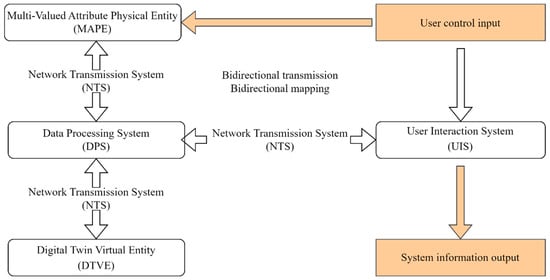
Figure 1.
Architecture diagram of Digital Twin Monitoring System for Roadheader.
It consists of five basic parts: multi-valued attribute physical entity (MAPE), digital twin virtual entity (DTVE), data processing system (DPS), user interaction system (UIS), and network transmission system (NTS).
2.1.1. Multi-Valued Attribute Physical Entity
The multi-valued attribute physical entity, namely the physical entity of concern in the system architecture, constitutes the basis of the entire system’s composition. The multi-valued attributes of the physical entity primarily encompass five characteristic attributes: physical, behavioral, geometric, rule-based, spatiotemporal, and scale. The multi-valued attribute physical entity is a collection consisting of the roadheader body and the sensing elements of the working environment. Simultaneously, data collection is the fundamental step for realizing the digital twin of the roadheader. The core data of the roadheader during the cutting process are the position and orientation data of the roadheader and the working environment data. Both jointly form the data source of the digital twin monitoring system of the roadheader. The data generated during the operation process of the multi-valued attribute physical entity are encoded and mapped to the digital twin virtual entity through the network transmission system and the data processing system to ensure the consistency, accuracy, and timeliness of the digital twin virtual entity.
2.1.2. Digital Twin Virtual Entity
The digital twin virtual entity is mainly a digital model constructed through bidirectional mapping of the characteristic attributes of the concerned entity. The digital twin monitoring system of the roadheader in this paper focuses on the geometric and behavioral attributes of the roadheader during the cutting process. The geometric attribute describes the main geometric parameters of the roadheader, such as the shape, size, and position of the parts, which can rationally reflect the contour appearance of the physical entity. The behavioral attribute portrays a series of behavioral responses produced by the roadheader under the interference of factors such as environmental disturbances, internal operating mechanisms, and human operations, encompassing the pose transformations of the main moving parts of the roadheader, the alterations in various physical parameters inside the roadheader, and the changes in the physical properties of the working environment.
2.1.3. Data Processing System
The data processing system is the core component of the digital twin monitoring system for the roadheader and the data center of the entire framework. The data generated by the multi-valued attribute physical entity, the digital twin virtual entity, and the user interaction system all need to be aggregated in the data processing system for analysis and processing. Essentially, the data processing system is a data engine that encapsulates various types of data, digital models, functional algorithms, tool programs, and data interfaces required during the operation of the digital twin monitoring system for the roadheader, such as the standardized encapsulation and storage management functions of twin data, data transmission protocols, data correction and analysis algorithms, cloud computing data interfaces, user function extension interfaces, etc.
2.1.4. User Interaction System
The user interaction system is the user interaction part of the digital twin framework and the medium through which the digital twin monitoring system of the roadheader establishes a relationship with the user. The user interface refers to the collection of the hardware or software aspects that the user can see (or hear or perceive in other ways), and the program mechanisms that the user uses to input their operations and data. The user is directly connected to it and interacts with it to carry out activities. User interface design is a comprehensive design of the way and process by which the user establishes an interactive behavior with the system. The parameters of the roadheader are sent to the control end through the industrial network, and a digital twin virtual entity of the roadheader is constructed on the control end device. The digital twin virtual entity is driven according to the received parameters of the roadheader cutting process to realize the synchronous actions of the virtual model and the physical entity, thereby achieving the construction of the roadheader monitoring control system and the cutting visualization assistance system.
2.1.5. Network Transmission System
The network transmission system is the transmission channel for data communication among the various sub-components within the digital twin framework and is the “blood system” of the entire digital twin monitoring system of the roadheader, providing data interaction for the dynamic real-time bidirectional interaction mapping of the entire system. The network transmission system transmits the operation information collected by the multi-valued attribute physical entity to each subsystem and sub-module of the digital twin monitoring system of the roadheader through transmission channels such as industrial Ethernet, fieldbus, intelligent gateway, and wireless network, based on communication protocols such as TCP/IP, MODBUS, and LonTalk serial communication, combined with 5G communication, industrial Internet, and Internet of Things technologies, to realize the information interaction and mapping feedback among the subsystems and sub-modules.
The above five modules work collaboratively to achieve the purpose of real-time monitoring of the roadheader. The process is shown in Figure 2.

Figure 2.
Operation process of DTMSR.
2.2. The Cutting Behavior Process of the Roadheader
Taking the EBZ55 roadheader as the research object, it is assumed that when the roadheader is on horizontal ground, the direction from the rear support to the cutting head and parallel to the horizontal plane is the front, the direction perpendicular to the ground and upward is the upper direction, and the left and right directions can be determined, as shown in Figure 3.
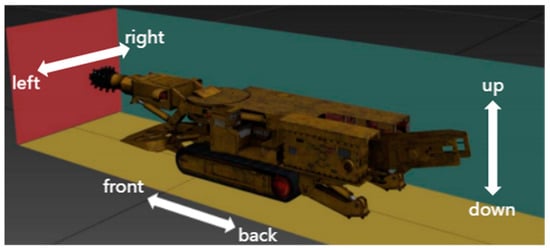
Figure 3.
Schematic diagram of direction marking of roadheader.
It is assumed that the initial state of the roadheader before operation is as follows: the slewing platform is in the middle position, and the rear support and the shovel plate are both at the positions where the strokes of their corresponding hydraulic cylinders are the smallest, as shown in Figure 4.

Figure 4.
Side view of the initial state of the roadheader.
The cutting arm is in the horizontal position, as shown in Figure 5, and the roadheader is at a certain distance from the cutting surface. The ideal roadway profile is selected as a semi-circular arch type. The main cutting process action steps of the roadheader are decomposed as follows:
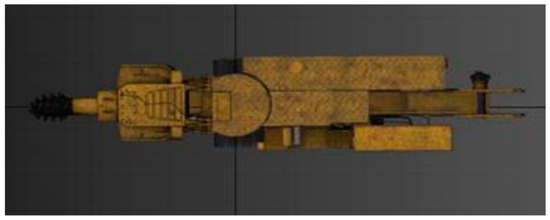
Figure 5.
Top view of the initial state of the roadheader.
- Start the rotation of the cutting head, and the star wheel and the transfer part rotate forward.
- The traveling part drives the fuselage forward, and the cutting head drills into the coal wall for an appropriate distance.
- The shovel plate swings downward, and the rear support swings downward to lift the fuselage.
- Adjust the cutting arm so that the cutting head is at the lower left corner of the ideal contour of the cutting surface.
- Control the cutting head to cut in an S-shaped route, and then perform wall brushing and floor cutting to complete the cutting cycle. The cutting path and the ideal roadway profile are shown in Figure 6.
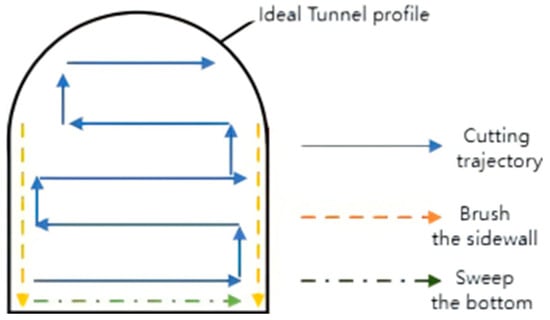 Figure 6. The cutting path and the ideal roadway profile.
Figure 6. The cutting path and the ideal roadway profile. - The cutting head drops and waits for the support operation.
Repeat the above action steps to complete the tunneling of the roadway.
2.3. Digital Twin Human–Computer Interaction Platform
The Hololens2 is selected as the hardware device for the roadheader mixed-reality human–computer interaction platform, enhancing the operator’s visual perception and enabling immersive, real-time monitoring of the excavation process, as shown in Figure 7.

Figure 7.
Picture of Hololens2 produced by Microsoft.
The mixed reality human–computer interaction platform (MRHCIP) is a software composed of a series of functional modules running on mixed-reality devices, included within the user interaction system, to realize the information interaction between the user and the digital twin monitoring system of the roadheader. The mixed reality human–computer interaction platform includes five major modules, the digital twin module (DTM), network communication module (NCM), user interaction module (UIM), data processing module (DPM), and function–extension interface (FEI), and its architecture is shown in Figure 8.

Figure 8.
Architecture of MRHCIP.
3. Construction of the Digital Twin Monitoring System
3.1. Construction of the Main Modules of the Digital Twin Monitoring System
It is crucial to reasonably arrange each module of the digital twin monitoring system to establish a two-way interactive channel for information and data and to achieve the visualization of the twin model. The construction methods of each module of the system are introduced below.
3.1.1. Digital Twin Geometric Model
The digital twin geometric model of the EBZ55 roadheader is established by using the combined modeling method of Unity3D (v2020.3.25f1c1), SolidWorks (v2019), and 3Dsmax (v2016). A communication connection is established with the physical roadheader via the TCP protocol to obtain operational data, drive the actions of the digital twin, and send feedback data. Then, by adjusting the parent–child relationship between the components of the digital twin geometric model of the roadheader, the motion relationship between them is determined. Moreover, by writing data-driven scripts and component motion animations, the function of the data-driven digital twin of the roadheader is realized (Figure 9).
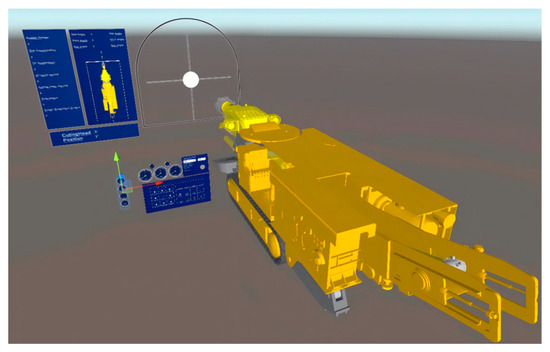
Figure 9.
The scene of the roadheader in Unity3D.
3.1.2. Network Communication Module
The network communication module is the data channel of the digital twin monitoring system for the roadheader. It connects to the twin data processing program using the TCP/IP protocol to achieve two-way exchange and two-way mapping of virtual and real data. The data protocol reads the required information in the byte stream according to different communication rule algorithms, and simultaneously converts the information within the client into a byte stream and sends it to the server. Correspondingly, when sending data, the network communication module reads the twin information and environmental information of the roadheader, encodes and concatenates this information according to the protocol, converts it into a byte stream, and sends it to the twin data exchange processing program of the roadheader.
3.1.3. Human–Computer Interaction Interface
The position and behavior information of the roadheader during underground operations is perceived through sensors, and then sent to the digital twin monitoring system via the network for analysis and identification, and the results are stored in a temporary array. The system then reads the corresponding data to complete the dynamic update of the information on the human–computer interaction interface.
The human–computer interaction interface is divided into two parts, as shown in Figure 10. The right side shows the real-time position of the cutting head in the roadway section, as well as the running trajectory and cutting range of the cutting head. The left side shows information such as the yaw angle, pitch angle, and roll angle of the roadheader in the roadway, allowing the driver to fully understand the body posture of the roadheader.

Figure 10.
Demonstration of cutting track vision-assisted module.
The gesture recognition function of Hololens2 is utilized and a program control panel is developed to complete the interaction between humans and machines. The program control panel is used to receive the control signals of the user, thereby achieving the behavior control of the digital twin of the roadheader, including the network information input module, parameter display components, functional menus, and the control panel of the roadheader (Figure 11).

Figure 11.
Program control panel.
3.1.4. User Controller
The mixed-reality platform has a relatively convenient interaction method. It can connect an external user controller, namely a remote control handle, through wireless or wired means, thereby expanding the interaction means for users. The real controller of the roadheader underground is shown in Figure 12. The control script within the program will generate a key value table based on the number of keys and perform cyclic detection in each frame. When a key value is detected to be triggered, the specified function is called to achieve the control of the digital mirror entity of the roadheader.

Figure 12.
Controller of the roadheader.
3.1.5. Data Processing Module
The data processing module is the core component of the entire mixed-reality human–computer interaction platform, responsible for the calculation and analysis of the data flow within the entire program. The byte stream composed of the information segments will be decomposed into independent data fields after being processed and segmented by the network communication module, and these fields will be stored in a temporary data pool for other modules to call. The data processing module will perform secondary processing of this information and convert it into the format required by the program. Take the information segment composed of the twin model of the roadheader’s cutting motion as an example. The data processing module will store the control right indicator in a temporary variable to record the client where the control right of the roadheader is located in the current system. However, there are a large number of action parameters and status parameters during the transmission process, and the data format does not meet the requirements of the TCP protocol. Therefore, the original data will be encoded, such as converting from floating-point numbers (float) to bytes (byte). This can reduce the volume of each information segment while retaining sufficient information, thereby improving the transmission efficiency. The data processing module will then perform secondary processing on this information and convert it into the format required by the program. In addition, the data processing module can use the function extension interface to connect to the algorithm programs of other functions and export the sensor information of the roadheader to be calculated outside the program to obtain the results required by the user.
During the functional development process of the digital twin monitoring system based on mixed-reality technology, the addition of subsequent new functions will also be considered. To avoid the inconvenience caused by modifying the original program itself, function extension interfaces will be reserved in advance during the development of the program.
3.2. Construction of the Exchange System Twin Data
The roadheader twin data exchange processing program is the information hub in the architecture of the roadheader digital twin monitoring system and is an important program for data exchange. It adopts a C/S communication architecture and is responsible for data collection, forwarding, recording, and storage within the entire system architecture, corresponding to the data processing module. After the sensors on the physical entity of the roadheader obtain the position and movement of the roadheader, the data processing program on the roadheader body will process, encode, and package the sensor data, and then use the data transmission module to send the operating data of the experimental prototype to the twin data exchange processing program. Among them, the data storage module and the network connection module are the two main working modules.
3.2.1. Data Storage Module
Data storage is an important process for recording the data flow within the system, enabling the reuse and secondary mining of data to fully utilize its inherent value. The MySQL (v8.0) software is used as the system database of the roadheader digital twin monitoring system. When the program starts, it will connect to a specified database in MySQL on the corresponding computer. After receiving the data from any client, it first completes the data verification and sends the verification result to the user panel, then calls the relevant functions of the database interface to store the current data in the specified database according to the format.
3.2.2. Network Connection Module
The network connection module is the information hub in the twin data exchange processing program. Its essence is a socket communication server, and its framework and performance directly determine the communication efficiency performance between client application programs.
The network connection module is divided into four parts: the network service layer, the business logic layer, the data access layer, and the user interaction layer, as shown in Figure 13.

Figure 13.
Architecture of network connection module.
The network service layer is mainly used for monitoring socket connections, creating sockets, receiving messages, sending messages, and closing connections. To ensure real-time synchronization between the physical roadheader and its virtual model, a timestamp synchronization mechanism is implemented. Each transmitted data packet is tagged with a timestamp, allowing the business logic layer to align incoming data with its respective time marker, reducing discrepancies between the physical and virtual states.
In addition, two key mechanisms are incorporated into the data transmission process to improve system performance. First, a data lightweighting algorithm is employed to reduce the volume of data being transmitted, improving transmission efficiency and reducing bandwidth consumption. Second, a lightweight error correction algorithm is used to detect and correct errors in data packets. This ensures the integrity of the transmitted data. Error correction includes the use of checksums and cyclic redundancy checks (CRC) for verifying data integrity, along with a forward error correction (FEC) approach to recover lost or corrupted packets, thereby enhancing the robustness and reliability of bidirectional interactions.
The network service layer transfers the content of the fragmented information segments to the business logic layer. After receiving the content of the information segments, the business logic layer parses the information and then proceeds to the corresponding processing flow. Due to the differences in the types of clients connected to the server, the network service layer of the twin data processing program does not actively send information. The network service layer provides interface functions for sending messages for the business logic layer to call. The operation of sending information is controlled by the business logic layer. The business logic layer integrates and encodes the information according to different data protocols based on the specific business applications of different clients and different information segment formats and calls the information sending interface to send the data to the designated client. The function of the data access layer is the data interaction between the server and the database. Separating the data access layer from the network service layer reduces the coupling of the programs within the network connection module. Multi-threaded programming is used to achieve the parallel operation of the network service layer and the data access layer, saving the waste of CPU cycles and improving the efficiency of the application program.
4. Laboratory Experiment of the Roadheader Digital Twin Monitoring System
To test the performance of the digital twin monitoring system for the roadheader, an experimental prototype of the roadheader was established with the EBZ55 roadheader as the prototype and a size design at a ratio of 1:11, as shown in Figure 14. The control module of the roadheader experimental prototype is implemented using a Raspberry Pi 4B microcomputer. The Raspberry Pi 4B features an advanced ARM architecture and utilizes SD/MicroSD cards for storage. It is capable of running Linux-based operating systems and supports the expansion of various hardware components, making it a versatile control platform.
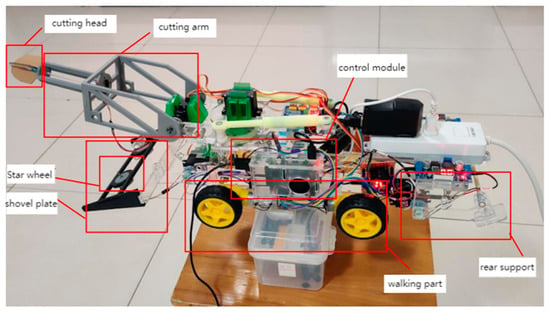
Figure 14.
Experimental prototype of roadheader.
The angle variables, including the movements of the shovel plate, cutting arm, rear support, and slewing platform, are simulated using MG996R small DC servo motors. A total of four servo motors are deployed in the experimental prototype to replicate the four key actions: the up-and-down pitching motion of the cutting arm, the left-and-right swinging motion of the slewing platform, the up-and-down swinging motion of the shovel plate, and the up-and-down movement of the rear support. These servo motors offer two primary modes: adjustable full-angle speed and adjustable partial-angle position. They convert input voltage into motor speed and torque to drive the rotor, achieving precise position adjustments. Their notable features include controllable operating speed, high positional accuracy, a small electromechanical time constant, and excellent linearity.
In addition, the state variables—representing the movement information of the traveling part, star wheel, transfer part, and cutting head—are simulated using DC motors. Together, these components provide a comprehensive representation of the roadheader’s key functional movements in the experimental prototype.
The angle sensor utilized in this study is the JYME01-TTL high-precision angle sensor, which offers an angular accuracy of up to 0.1°. This level of precision aligns with the performance of most high-precision angle sensors commonly employed in roadheaders available on the market. The JYME01-TTL sensor ensures reliable and accurate angle measurements, supporting the precise control and monitoring requirements of the digital twin-based system in complex operational environments.
Based on this experimental prototype, the simulation experiment mainly examines the accuracy and timeliness of the virtual mapping of the digital twin monitoring system for the roadheader, simulates the behavioral actions such as walking, raising and lowering the front shovel plate and rear support, starting the cutting head and star wheel, and cutting the coal wall along the trajectory during the tunneling operation of the roadheader, and records the angles and corresponding moments of the actions of the experimental prototype.
4.1. Bidirectional Mapping Test of Cutting Behavior
We next conducted a bidirectional mapping test of the cutting behavior. In the experiment, the local remote controller of the roadheader test prototype model and the virtual operation end control panel in the mixed-reality human–computer interaction software were operated, and the operations were carried out according to the steps of the cutting operation process for the “virtual reflecting reality” and “virtual controlling reality” tests. The bidirectional mapping test of the cutting operation behavior data can realize the transmission of control signals and behavior information between the roadheader test prototype model and the digital twin model and achieve the synchronization of simple actions of the virtual and real twins, as shown in Figure 15.
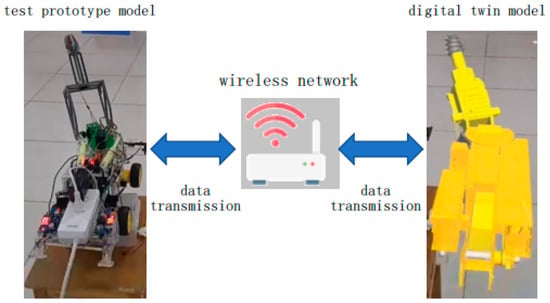
Figure 15.
Synchronization of real and virtual roadheader actions.
4.2. Visual Monitoring Test
In the experiment, the cutting head trajectory monitoring program was activated, and the current position and cutting range of the cutting head were displayed on the human–computer interaction interface. Based on the consistency of behaviors between the virtual and real twins, the position and posture information of the cutting arm was obtained through the cutting head position algorithm and sensors, and the movement trajectory and cutting range of the cutting head were displayed. At the same time, the position and posture parameters and operating status of the roadheader were displayed in real-time on the human–computer interaction interface. The test process is shown in Figure 16.

Figure 16.
Diagram of the test process. (a) Lower the shovel plate and the rear support. (b) Cut along the trajectory. (c) Brush the sidewall. (d) Sweep the bottom.
4.3. Accuracy Validation of the Digital Twin
The movement positions of the cutting arm, shovel plate, rear support, and slewing platform can all be represented by the mechanism angles. During the cutting operation, the angles of the up and down swinging of the cutting arm and the left and right rotation of the slewing platform are monitored. This monitoring can be used to evaluate the accuracy of the virtual twin of the monitoring system. Assuming that the angle values of the cutting arm and the slewing platform in the initial state are both 90°, the angle values of the two components are collected every 0.5 s, and the curve graphs are plotted with time as the abscissa and the angle values as the ordinate, as shown in Figure 17 and Figure 18.

Figure 17.
Angle curve of cutting arm.
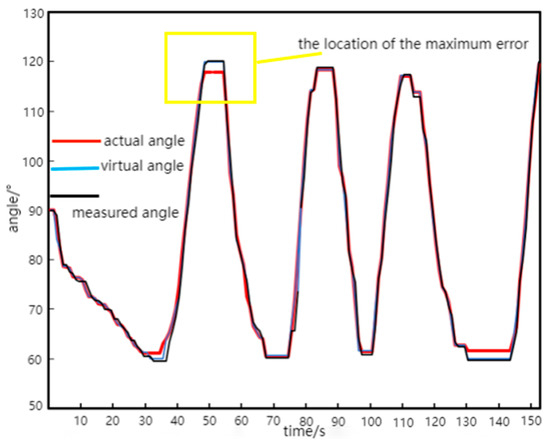
Figure 18.
Angle curve of slewing platform.
The error that occurred during the data transmission process of the roadheader test prototype model and the digital twin model, which is recorded as the “transmission error”, reflects the error in the data transmission process from the actual system to the virtual system. The difference between the virtual angle (blue line) and the actual angle (red line) in Figure 17 and Figure 18 is the transmission error. The error in the execution process of the servo motor is recorded as the “measurement error”. This error reflects the difference between the actual execution angle and the theoretical calculated angle during the execution process of the servo motor. The difference between the measured angle (black line) and the virtual angle (blue line) in Figure 17 and Figure 18 is the measurement error. It is defined that the downward swing of the cutting arm is in the direction of increasing value. Taking time as the abscissa and the error percentage as the ordinate, the error scatter plots are drawn as shown in Figure 19 and Figure 20. Similarly, the rightward swing of the slewing platform is in the direction of increasing value, and the error scatter plots are shown in Figure 21 and Figure 22. The black dots in the chart represent the recorded error values per unit of time, where negative values indicate a direction opposite to the defined positive direction.
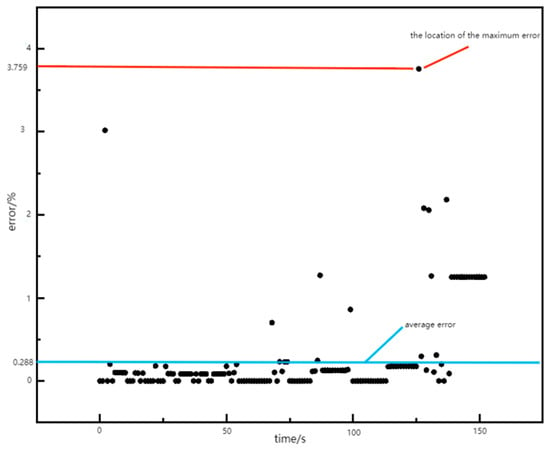
Figure 19.
Transmission error of cutting arm angle.

Figure 20.
Measurement error of cutting arm angle.

Figure 21.
Transmission error of slewing platform angle.
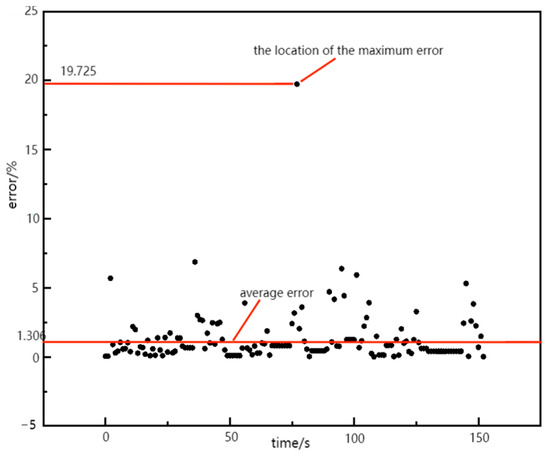
Figure 22.
Measurement error of slewing platform angle.
Based on the above data, the following conclusions are summarized:
- Timeliness of virtual mapping. The operating information of the roadheader test prototype model can be quickly transmitted to the digital model to achieve the action synchronization of the two. The delay time difference scatter plot is shown in Figure 23. After measurement and calculation, the average delay is 60 ms, and the timeliness is good.
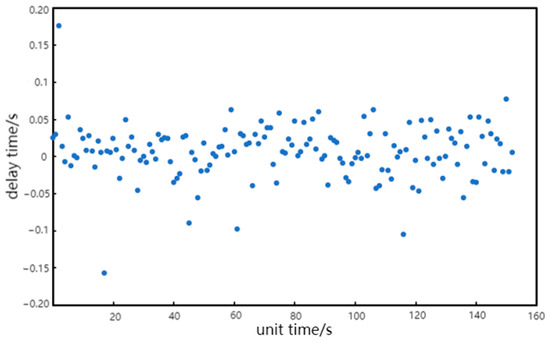 Figure 23. Scatter plot of delay time difference.
Figure 23. Scatter plot of delay time difference. - Accuracy of virtual–real interaction. The angle values of the mechanism motion positions between the roadheader test prototype and the digital model are highly consistent. The maximum transmission errors of the cutting arm and the slewing platform are 3.756% and 5.000%, respectively, and the average transmission errors are 0.288% and 0.757%, respectively. There are mainly two reasons for the generation of transmission errors: Firstly, field loss occurs during the process of data format conversion and splitting, resulting in a deterioration in the accuracy. Secondly, the program cannot process data in a timely manner during the measurement process, resulting in data delay, thereby causing deviations in the observed data.
- Reliability of virtual–real interaction. The measurement errors generated during the action execution process of the roadheader test prototype model are relatively large, with the maximum values being 15.028% and 19.725%, respectively, and the average values being 3.695% and 1.306%, respectively. Although the maximum values are large, the average values are both lower than 3.700%, so they basically meet the accuracy requirements. There are the following three reasons for the generation of the measurement errors: Firstly, errors arise due to the insufficient accuracy of the actuator of the test prototype and the existence of a large rotation dead zone. At the same time, there is accuracy loss in the process of the digital signal to electrical signal conversion and pulse signal length calculation, inevitably leading to observation errors. Secondly, there are a few moments with large delays during the signal transmission and execution process, which leads to the action delay of the actuator and thus causes large deviations. Finally, problems such as the accuracy of the sensor and the jitter of the servo motor will further expand the error.
In conclusion, through the analysis of the test results, the following conclusions can be drawn: The architecture of the roadheader digital twin monitoring system can complete the “bidirectional mapping and bidirectional transmission” of the roadheader cutting data between the physical entity and the virtual entity with a high accuracy and fast speed, thereby achieving bidirectional control of the behaviors and synchronization of the actions of the multi-dimensional attribute physical entity and the twin virtual entity. At the same time, supported by the mixed-reality technology, the roadheader driver can understand the working status of the roadheader during the cutting operation more quickly and stereoscopically, improving the accuracy of monitoring and the efficiency of the cutting work.
5. Conclusions
This paper aims at solving the problems that cannot be completely solved by traditional monitoring technologies such as the complex operating environment, high incidence of accidents, and out-of-sight tunneling information during the underground operation of roadheaders. By combining the advantages of digital twin and mixed-reality technologies, a digital twin monitoring system for roadheaders is established. The digital twin includes five basic parts: the multi-dimensional attribute physical entity, digital twin virtual entity, data processing system, user interaction system, and transmission network connection system by analyzing the working operation process and characteristics of the boom-type roadheader. Combined with the TCP/IP protocol and C/S network architecture, the efficient, accurate, and rapid transmission of the roadheader cutting information is realized for the digital twin monitoring system, achieving the behavior synchronization and bidirectional control of the virtual and real roadheaders. Through an MR human–computer interaction platform, the virtual roadheader is driven and displayed by the motion data of the roadheader model, which was collected and transmitted to the UIS, where the physical entity and the digital object coexist collaboratively. The data exchange program is designed using the Winform framework and socket communication method, and the digital twin data exchange system of the roadheader is established to provide an information transfer platform for the bidirectional transmission and format conversion of data within the system and combined with the MySQL (v8.0) database for data storage. Some of our conclusions are as follows:
- The roadheader digital twin monitoring system enables users to fully display the operating status and environmental changes of the roadheader, assists users in completing information identification beyond the line of sight, and improves the efficiency of users’ information acquisition, achieving the bidirectional mapping and bidirectional interaction between the digital model and physical entity.
- The operating information of the roadheader experimental prototype can be quickly transmitted to the digital model to achieve the action synchronization of both. After measurement and calculation, the average delay is 60 ms, and the timeliness is good.
- The motion angle values of the roadheader prototype and the digital model are highly consistent. The maximum angle transmission errors of the cutting arm and the slewing platform are 3.756% and 5.000%, respectively, and the average transmission errors are 0.288% and 0.757%, respectively, and the accuracy is good.
- The measurement errors generated during the action execution process of the roadheader prototype model are relatively large, with the maximum values being 15.028% and 19.725%, respectively, and the average values being 3.695% and 1.306%, respectively. Although the maximum values are large, the average values are both lower than 3.7%, so they basically meet the accuracy requirements.
6. Limitations and Future Research Directions
6.1. Limitations of This Study
The present study is limited to a conceptual framework and initial validation using an experimental prototype of the roadheader, rather than a full-scale real-world system. While this approach effectively demonstrates the feasibility of the digital twin framework and bidirectional mapping capabilities, it does not fully address the complex conditions encountered in real mining operations, such as varying rock properties, uneven terrain, and dynamic environmental factors. Additionally, the system validation experiments were conducted under controlled conditions, excluding common underground challenges like dust, electromagnetic interference, and low visibility, which may significantly affect system performance. Although the mixed-reality interface shows potential to enhance the operator’s visual perception, this study primarily focuses on technical aspects and does not quantitatively evaluate its usability or impact on decision-making processes.
6.2. Future Research Directions
Future research will extend the digital twin monitoring system to real-world roadheader operations to evaluate its performance under varying conditions, such as heterogeneous rock formations, uneven terrain, and complex underground environments. Experiments addressing environmental challenges like dust, electromagnetic interference, and lighting variations will be designed to ensure the system’s robustness and reliability in harsh mining conditions. To further enhance the operator experience, the mixed-reality platform could integrate advanced sensing technologies, such as LiDAR and thermal imaging, providing a more comprehensive view of the operational environment and supporting real-time decision-making. User-centered studies will be conducted to assess the system’s usability, focusing on its impact on operator efficiency, situational awareness, and decision-making accuracy. Additionally, future work will explore the cost-effectiveness of the system, addressing commercial implementation strategies, scalability, and long-term operational costs to ensure its practical viability.
Author Contributions
Conceptualization, X.H.; Methodology, X.H. and H.L.; Software, H.J.; Vali-dation, H.L. and H.J.; Formal analysis, X.H., H.L. and H.J.; Investigation, Y.C. and Y.G.; Resources, Y.C., S.W., Y.G. and J.G.; Data curation, S.W., J.G. and S.G.; Writing—original draft, H.L.; Writing—review and editing, X.H., H.J. and S.G. All authors have read and agreed to the published version of the manuscript.
Funding
This work was supported by the National Key Research and Development Program of China (grant number: 2022YFC2904105), National Key Research and Development Program of China (grant number: 2023YFC3010400), and Key Research and Development Program of Hebei Province (grant number: 23311805D).
Institutional Review Board Statement
Not applicable.
Informed Consent Statement
Not applicable.
Data Availability Statement
The original contributions presented in the study are included in the article, further inquiries can be directed to the corresponding author.
Conflicts of Interest
The authors declare no conflicts of interest.
Abbreviations
The following abbreviations are used in this manuscript:
| MR | Mixed Reality |
| AR | Augmented Reality |
| VR | Virtual Reality |
| DTMSR | Digital Twin Monitoring System for Roadheader |
| MAPE | Multi-Valued Attribute Physical Entity |
| DTVE | Digital Twin Virtual Entity |
| DPS | Data Processing System |
| UIS | User Interaction System |
| NTS | Network Transmission System |
| CRC | Cyclic Redundancy Checks |
| FEC | Forward Error Correction |
References
- Mao, J.; Dong, Y.; Lu, J.; Li, Y.; Zhang, H.; Xie, M.; Wu, X.; Liu, Z.; Wang, H.; Tian, B. Research Status and Prospects of Advanced Technology in Roadway Tunneling and Drilling. Coal J. 2021, 46, 2084–2099. [Google Scholar]
- Xu, B. Analysis of Deep Mining in Coal Mines and Disaster Prevention in China. China Pet. Chem. Stand. Qual. 2020, 40, 192–193. [Google Scholar]
- Comakli, R.; Kahraman, S.; Balci, C. Performance Prediction of Roadheaders in Metallic Ore Excavation. Tunn. Undergr. Space Technol. 2014, 40, 38–45. [Google Scholar] [CrossRef]
- Roman, M.; Breido, J.; Drijd, N. Development of Position System of a Roadheader on a Base of Active IR-sensor. Procedia Eng. 2015, 100, 617–621. [Google Scholar] [CrossRef][Green Version]
- Corke, P.; Roberts, J.; Cunningham, J.; Hainsworth, D. Mining Robotics. In Springer Handbook of Robotics, 2nd ed.; Springer: Berlin/Heidelberg, Germany, 2008; pp. 1127–1150. [Google Scholar]
- Jiang, X.X.; Li, C.X. Statistical Analysis on Coal Mine Accidents in China from 2013 to 2017 and Discussion on the Countermeasures. Coal Eng. 2019, 51, 101–105. [Google Scholar]
- Xie, H.P.; Wu, L.X.; Zheng, D.Z. Prediction on the Energy Consumption and Coal Demand of China in 2025. J. China Coal Soc. 2019, 44, 1949–1960. [Google Scholar]
- Zhang, W.; Zhai, G.; Yue, Z.; Pan, T.; Cheng, R. Research on Visual Positioning of a Roadheader and Construction of an Environment Map. Appl. Sci. 2021, 11, 4968. [Google Scholar] [CrossRef]
- Wu, J.; Yang, Y.; Cheng, X.; Zuo, H.; Cheng, Z. The Development of Digital Twin Technology Review. In Proceedings of the 2020 Chinese Automation Congress (CAC 2020), Shanghai, China, 6–8 November 2020; pp. 4901–4906. [Google Scholar]
- Agrawal, A.; Fischer, M.; Singh, V. Digital Twin: From Concept to Practice. J. Manag. Eng. 2022, 38, 06022001. [Google Scholar] [CrossRef]
- Liu, Y.P.; Liu, Y.J.; Lu, F.C. Application Prospects and Key Technologies of Digital Twin in Transmission and Transformation Equipment. High Volt. Eng. 2022, 48, 1621–1633. [Google Scholar]
- Bao, J.; Zhang, R.; Li, J.; Lu, Y.; Peng, T. Digital Twin Collaboration Technology Oriented to Human-Machine-Environment Integration. J. Mech. Eng. 2022, 58, 103–115. [Google Scholar]
- Tekinerdogan, B. On the Notion of Digital Twins: A Modeling Perspective. Systems 2023, 11, 15. [Google Scholar] [CrossRef]
- Ge, S.; Fan, Z.; Shibo, W. Research on Digital Twin Smart Mining Face Technology Architecture. J. Coal Sci. 2020, 45, 1925–1936. [Google Scholar]
- Zhang, X.; Zhang, C.; Wang, M.; Wang, Y.; Du, Y.; Mao, Q.; Lyu, X. Virtual Control Technology of Cantilever Roadheader Driven by Digital Twin. Comput. Integr. Manuf. Syst. 2021, 27, 1617–1628. [Google Scholar]
- Zhang, C.; Zhang, X.; Zhang, K.; Xie, N.; Zhou, C. Remote Automatic Cutting Control Technology of Roadheader Driven by Digital Twin. Mine Autom. 2020, 46, 15–20+32. [Google Scholar]
- Wang, S.; Du, Y.; Xue, G.; Tian, J.; Wu, M. Research and Application of Roadheader Remote Control Technology and Monitoring System. China Coal 2013, 39, 63–67. [Google Scholar] [CrossRef]
- Hu, W.; Fang, J.; Liu, F. Real-time State Mapping of Roadheader Based on Digital Twin. J. Hunan Univ. (Nat. Sci.) 2022, 49, 1–12. [Google Scholar]
- Fan, G. Application and Future Development of Virtual Reality Technology in Media Industry. Media 2020, 6, 22–26. [Google Scholar]
- Ogunseiju, O.R.; Gonsalves, N.; Akanmu, A.A.; Bairaktarova, D.; Bowman, D.A.; Jazizadeh, F. Mixed Reality Environment for Learning Sensing Technology Applications in Construction: A Usability Study. Adv. Eng. Inform. 2022, 53, 101637. [Google Scholar] [CrossRef]
- Fang, L.; Liu, Z.; Wu, M. Intelligent Optimal Control Considering Dynamic Posture Compensation for a Cantilever Roadheader. Robotica 2021, 40, 583–598. [Google Scholar] [CrossRef]
Disclaimer/Publisher’s Note: The statements, opinions and data contained in all publications are solely those of the individual author(s) and contributor(s) and not of MDPI and/or the editor(s). MDPI and/or the editor(s) disclaim responsibility for any injury to people or property resulting from any ideas, methods, instructions or products referred to in the content. |
© 2024 by the authors. Licensee MDPI, Basel, Switzerland. This article is an open access article distributed under the terms and conditions of the Creative Commons Attribution (CC BY) license (https://creativecommons.org/licenses/by/4.0/).